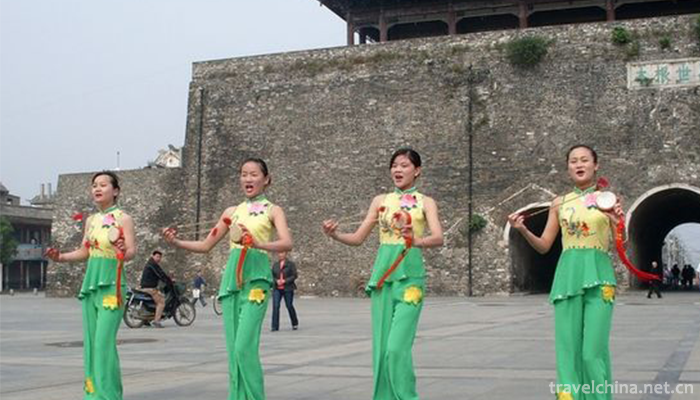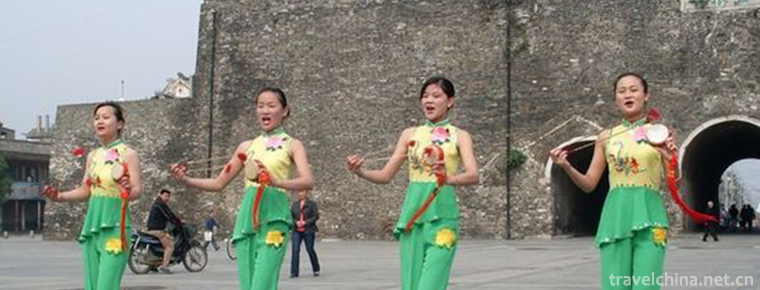Fengyang folk songs
Fengyang folk songs
Fengyang folk song is a traditional folk song in Anhui Province. Fengyang folk song in Fengyang flower drum is one of the important components of Fengyang folk song. Under the influence of immigrant culture in the early Ming Dynasty, Fengyang folk songs were renovated historically and developed greatly, and became famous both at home and abroad. The earliest record of Fengyang folk songs in written form is the legend of Hongmei Ji written by Zhou Chaojun in the Wanli period of Jiajing in Ming Dynasty.
On May 23, 2011, Fengyang Folk Songs were listed in the third batch of national intangible cultural heritage list with the approval of the State Council.
artistic characteristics
Fengyang folk song has a wide range of popularity. It expresses the joys, sorrows and sorrows of the working people's lives, and is a true portrayal of social life in different historical periods in China. With Fengyang Flower Drum as the carrier, "Beating Flower Drum" and other tracks, it has a significant impact on the Musical Singing of many kinds of music in our country. After the early Ming Dynasty, Fengyang Folk Songs, especially in the south of the Yangtze River, Beijing and Shanxi Province, have been playing an important role in China with the immigrants selling their skills everywhere to survive. According to historical records, except Xinjiang and Tibet, the melody of Fengyang folk songs has been floating in other parts of China.
After the late Qing Dynasty, more than 300 Fengyang folk songs were often circulated. At the beginning of the twentieth century, Fengyang folk song was one of the folk arts that entered records at that time. According to incomplete statistics, more than 10 tracks were recorded and became popular. Among them, the song "Fengyang Flower Drum" sung by Golden Voice is sung all over the land of Shenzhou.
In addition to entertaining the people, Fengyang folk songs have great influence on current affairs in different historical periods in China. During the Anti-Japanese War, Ann E compiled lyrics and Ren Guang compiled music. Li Lili sang "New Fengyang Song" for a while. Before and after 1949, in order to cooperate with the work of the local center, Fengyang people created a large number of new folk songs serving the current affairs, such as "Five Curses against Chiang Kai-shek", "Land Reform Chant", "Sending Langs to the Army", "Five Gentlemen to Govern Huaihe River" and so on, which played a great role in propaganda and inspiration.


-
1.Guangdong Marine Silk Road Museum
The Guangdong Marine Silk Road Museum is located on the "Shili Silver Beach" of Hailing Island Experimental Development Zone, Yangjiang City, Guangdong Province. The total construction area
Time 2019-01-13 -
2.Zhou Qiao old street
Zhouqiao Old Street is a national AAAA tourist attraction. The old street of Ximen in Jiading is located on the west side of Bole Square in downtown Jiading
Time 2019-01-21 -
3.Longwan Seaside Scenic Area
Longwan Beach, also known as Longwan Beach Scenic Area, spans Xingcheng City and Longgang District. The total length of the coastline is more than 3000 meters, covering an area of 10.9 square kilomete
Time 2019-02-06 -
4.Song and dance duet
Errentai is commonly known as Dual Items, two classes. Originated in Shanxi and growing up in Inner Mongolia, it is a traditional opera popular in the central and Western Inner Mongolia Autonomous Reg
Time 2019-04-29 -
5.Haicheng Hornplay
Haicheng trumpet opera, the local traditional drama of Anshan City, Liaoning Province, is one of the national intangible cultural heritage.
Time 2019-05-02 -
6.Mongolian Sawurden
Mongolian Sawurden, Xinjiang Uygur Autonomous Region and Jingxian traditional dance, one of the national intangible cultural heritage.
Time 2019-06-04 -
7.Handmade Weaving Techniques of Wood Machine Cosmetics
Nanjing Yunjin wooden machine makeup and hand-weaving skills, the local traditional skills of Nanjing, Jiangsu Province, one of the national intangible cultural heritage.
Time 2019-06-07 -
8.Wuyin Opera
Wuyin opera has a history of nearly 300 years. Its singing style is graceful and charming. It is known as "Northern Yue Opera". Its occurrence, development and finalization have gone through
Time 2019-06-29 -
9.Xunyang Folk Song
Xunyang Folk Song is one of the local folk songs in Xunyang County, Ankang City, Shaanxi Province. It has a long history, rich melodies, various types and different styles. Like other folk art forms,
Time 2019-07-09 -
10.Bao Yugang
In early years, he entered Shanghai Zhongxing school. Wusong merchant shipping Academy 。 Drop out of school in 1937 Central Trust Bureau Hengyang office, deputy manager of Hengyang branch of China Ind
Time 2019-09-06 -
11.History and culture of Mianyang
Located 47 kilometers south of Santai County, Qijiang ancient town was once the capital of Qi state during the spring and Autumn period and the Warring States period. Every year on the 27 to 28 May of the lunar calendar, all the male and female believers around
Time 2020-12-14 -
12.Climate of Nanchong
Nanchong belongs to the subtropical humid monsoon climate. Compared with the Yangtze River Valley in the south of the basin, the temperature is relatively low, the rainy season is longer and the rainstorm is more. Compared with the Western Sichuan plain
Time 2020-12-17